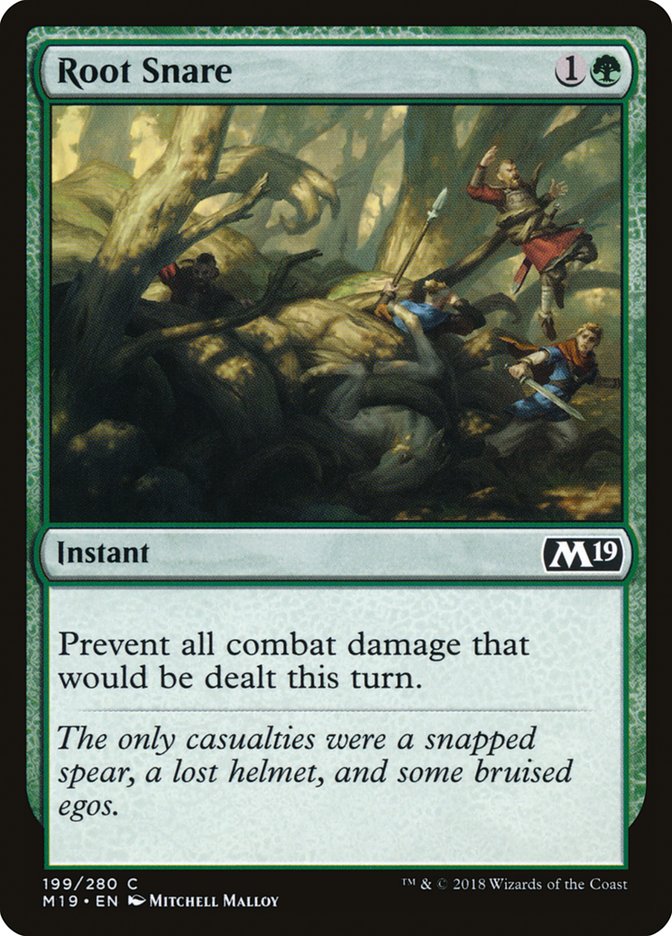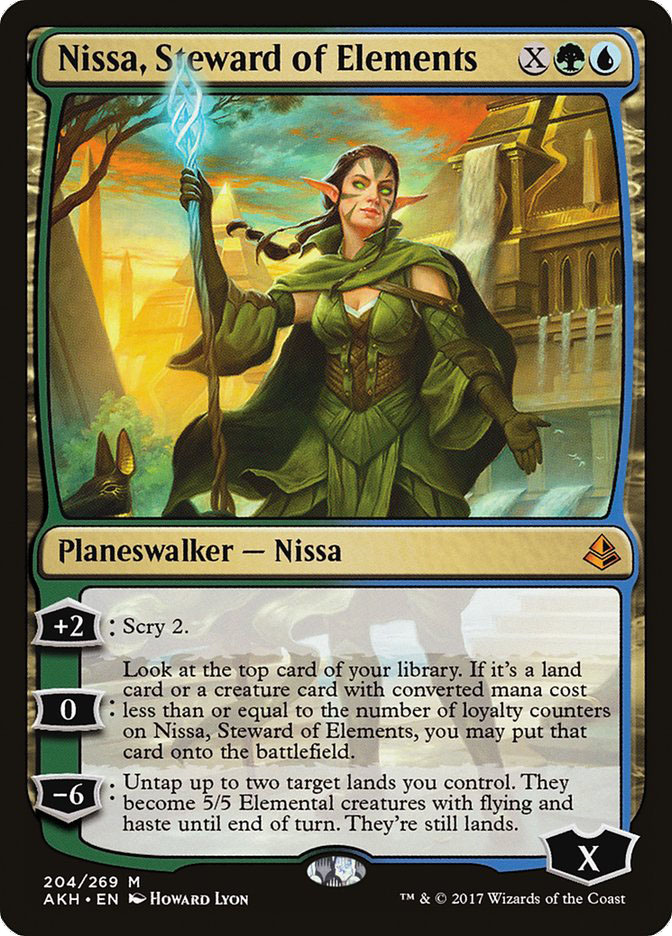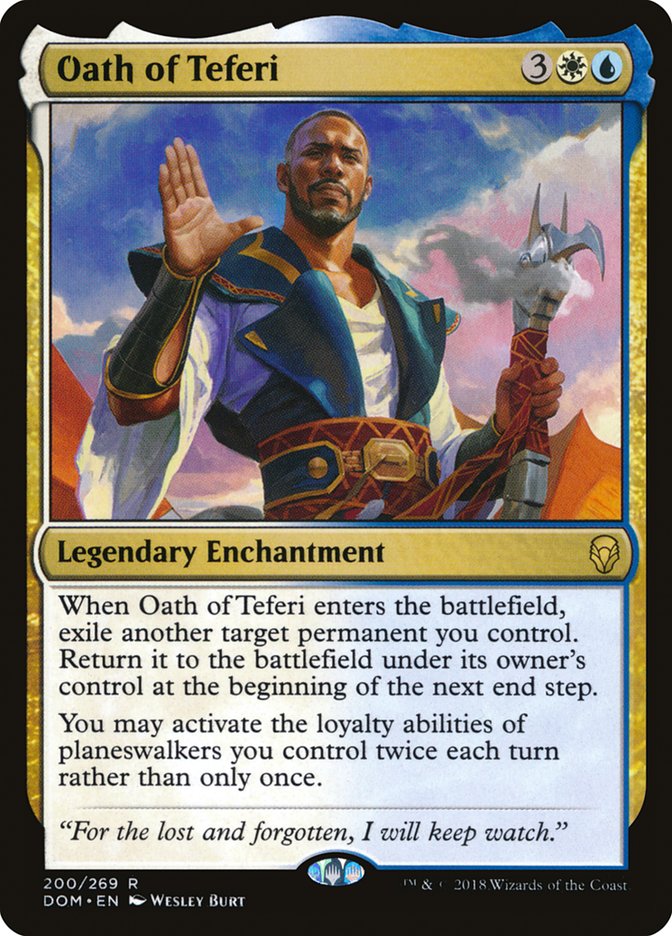On Tuesday, July 24th I signed into my computer to continue my preparation
for Pro Tour 25th Anniversary. Thus far, my preparation had consisted of
playing a league or two with each of the decks I saw as a potential player
in the Standard metagame. My lean at this point was U/W Control, a deck I
had played in the first Grand Prix of the previous season and had enjoyed
the feel of playing. I’d tried a few spicy additions like Chromium, the
Mutable from Core Set 2019, but concluded that a fairly boring
version was still optimal.
And then I read a post in our forum from brewmaster Gabriel Nassif, “This
fog deck went 10-3 against R/B, I think it merits serious consideration.” I
perused the list and was at the same time excited and horrified. It had
Teferi, Hero of Dominaria, my favorite card in Standard; it was ramping
into Teferi, something I’d always wanted to try but never found a good
shell for; and it was certainly off the radar. But what about all those
fogs!?
Planeswalkers (6)
Lands (17)
Spells (37)

What I had a really hard time getting out of my craw was the notion that
we’d be playing a white and blue creatureless deck without lots of
Fumigates and Settle the Wreckages. Somehow fogs would be better? It didn’t
make much sense to me.
But I had plenty of time to fall back on my U/W Control deck and explore
Gab’s project a little. We confirmed that the deck was indeed strong
against R/B Aggro and absolutely brutal against Mono-Green Aggro as long as
they weren’t splashing for counterspells. Next, I played my U/W deck
against Gab, in what would result in five long drawn out games. I won 4-1
with U/W Control, which elicited a comment like “Okay, bad matchup” from
Gab. But actually, from my side, it hadn’t felt lopsided at all. Game 1
seemed all about how many dead cards were drawn, and the sideboarded games
felt very intricate which meant room for us to have an edge because Bant
Nexus would be novel to most of our opponents.
At the risk of diverting us from playtest-storytelling, I think this
highlights a lesson that a lot of gamers could stand to learn: that is, you
simply don’t have time to conclusively test every matchup for your deck and
get a statistically significant result from your data. You might rack up
100 games in a few key matchups (which we probably did in ensuring Bant
Nexus was good against R/B) which is great. But paying attention to the
intuitive feel of games, what the matchup hinges on, and whether you feel
favored or not is key to efficient playtesting. If you’re testing in-house
– that is, not in a league on Magic Online – be sure to get feedback from
your opponent as well. While you’re at it, try and switch sides in the
middle of the matchup so it’s not just you advocating your deck. See how
your opponent handles some of the subtleties of playing the deck and you
might be pleasantly surprised. Playtesting is not just data-gathering, it’s
also an experience of learning the flow of the games and synthesizing your
impressions of the matchup with the actual results that you and your
teammates are getting.
As we continued to test Bant Nexus, it became my frontrunner and we started
to see its matchups like this:
-
VS Mono-Green Aggro: 85% match unless they have blue, in which case
it’s 45%. -
VS R/B Aggro: 55-80% depending on their configuration. More direct
damage and discard and small haste creatures were their potential
salvation. - VS U/W Control: Probably even.
-
VS Grixis Midrange: Really bad if they have lots of counters and
discard. Winnable if, like most Grixis lists, there are drowning in
dead cards game 1. -
VS Mono-Blue Paradoxical Outcome: A poor matchup where we needed a
plan.
I also came to understand that because we were leveraging an advantage
engine as ludicrously powerful as Teferi, a cheap and reliable (if not so
powerful) escape plan like Root Snare was actually quite reasonable. And
since we had no plans of gaining control of the battlefield from the combat
perspective, it often didn’t matter whether we Fumigated most of their
creatures or not- one annoying Hazoret or Scrapheap Scrounger could easily
do us in.
On that note, I benefited during several Pro Tour 25th Anniversary attack
steps from players navigating around Settle the Wreckages– which weren’t
even in my deck but were gifting me packets of life from the spooky
sidelines.
This isn’t to say that Bant Nexus is completely divorced from the
gamestate; simply fogging until it can repeatedly cast Nexus of Fate,
ultimate Teferi, exile the opponent’s side of the battlefield, and proceed
to an academic win. Many games do play this way, and we win with
Karn tokens, sideboard creatures, or just decking them by repeatedly
putting Teferi on top of our deck. But one of the most interesting parts of
playing the deck is deciding when we really need to take every
last turn of the game, and when we can instead hit the pause button.
For example, perhaps we’re facing R/B Aggro and they have a hoard of
creatures and Chandra, Torch of Defiance on the battlefield and a Cut in
their graveyard. We’re at a low life total and if we pass the turn now,
we’ll simply lose to direct damage from Chandra and the Cut even if we have
a fog for their creature onslaught. Our hope, then, is that either we get
to keep Time Walking forever, or that we can both get Chandra off the table
and gain enough life to survive the Ribbons aftermath. Luckily, this isn’t
so hard because we have Gifts of Paradise in our deck, and Teferi (that
dirty dog!) has a second ability which puts permanents two-down from the
top of their owners’ library. Thus, we can often play as a soft combo deck
that starts to go off and accumulates enough advantage that even if we
fizzle, there’s often a plan B like the one I described.

As I said, Teferi is the primary engine of the deck. But because he’s
legendary, he often needs a little help. Most lists you see will have
Search for Azcanta and Karn, but after that people seem to disagree on what
else to include. I played a Bounty of the Luxa and The Mirari Conjecture,
whereas David Williams skipped the Bounty of the Luxa, and Raphael Levy’s
group skipped both!
I haven’t sufficiently tried their replacements: Nissa, Steward of the
Elements and Oath of Teferi. But both seem very reasonable–Nissa in a
field with less aggressive decks and the Oath in matchups like the mirror
where you will have more threats than they can hope to counter and racing
becomes key.
You may have played against this deck or are envisioning trying it yourself
and wondering a little bit about the physical mechanics. Other than the
annoyance of tapping seven lands and clicking to submit your mana for Nexus
of Fate again and again (I enjoy Magic Online and look forward to them
improving this situation), the online experience with this deck is quite
smooth. Do not be fooled into thinking this will immediately translate into
live play! In fact, I did several time trials of going off and found that
not only did it take an uncomfortably long time, but I frequently committed
a game rules violation, forgot if I’d played a land, or if I’d activated a
planeswalker yet this turn.
I’ll admit that smooth mechanics and clean gameplay are not strengths of
mine, but I did come up with a crutch that might help you if you
‘re similarly concerned. While I was going off in the Pro Tour, I was very
careful to make a horizontal line of all my engine cards (those just
discussed), according to the order in which I planned to use them. This
meant Search for Azcanta first on the left (it happens on upkeep), Bounty
of the Luxa and/or The Mirari Conjecture second, Teferi third, and Karn
fourth. After I’d used each one, I’d turn it 45 degrees to the right (like
a half-tap) and then be clear that I’d already used it.
I still made a few game rules violations on the weekend, but this little
system probably saved me from imploding. A few notes: remember during your
untap step to ‘unhalf-tap’ these permanents as well, or your previous
tracking will sabotage your turn; also, when you look at your card for
Search of Azcanta, get in the habit of putting the card back on top of your
library (rather than straight into your hand) when you keep it. Without
this habit, you run the risk of skipping your chance to flip your Search to
the more powerful back side, because once the top card is in your hand,
you’re in your draw step and the window to flip Search is over.
How did we do with the deck? My understanding is that six players brought
the deck and recent accounts put the winrate at 73%. David Williams and I
fared a bit better, going a combined 22-6. Not bad.
So where does Bant Nexus go from here? From looking at the results of the
Pro Tour, there will be a big uptick in Teferi decks, both fog and U/W
Control. This means that maindeck countermagic is probably necessary.
Mono-Blue Paradoxical Outcome seems to be out of favor, so we don’t need to
worry about it as much, and green decks also seem to be on the downtick. We
also need to be weary of dedicated hate cards like Lost Legacy, Insult, and
Sorcerous Spyglass (scary stuff, if you ask me). All that considered,
here’s where I would start in testing Bant Nexus moving forward:
Planeswalkers (7)
Lands (16)
Spells (37)

VS R/B Aggro
Out:

In:

VS Mono-Green Aggro
Out:

In:

VS Grixis Midrange
Out:

In:

VS U/W Control
Out:

In:

VS Mono-Blue Paradoxical Outcome
Out:

In:

VS Bant Nexus
Out:

In:

Honorable Mentions
- Nezahal, Primal Tide is awesome. You might want two.
-
Commit is a great card, especially against opposing Nezahals and
for getting unpleasant permanents off the battlefield. -
Oath of Teferi is a card. I haven’t tried it, but others have liked
it. -
Torrential Gearhulk, with Supreme Wills in our deck, is a card that
looks worth trying out of the sideboard. -
It’s possible that the card draw suite I played at the Pro Tour is
better than this version. In that case you will want one or two
copies of The Mirari Conjecture. My favorite matchup for this card
is when the opponent has discard, as it can singlehandedly rebuild
your game.
Final Notes On Sideboarding
-
I’ve got a few Manglehorns coming in against R/B Aggro and
Mono-Green Aggro. The hedge here is against Sorcerous Spyglass,
which seems like the common hate card you’ll face out of these
decks because it has applications in other matchups they might
face. Manglehorn also kills Bomat Courier, a strong card against
Bant Nexus, as well as Heart of Kiran and Scrapheap Scrounger,
which appear in both decks. -
Another important consideration is time on the clock. If you need a
quick win, lean toward keeping Nissa and the Karns in your deck. If
you are up 1-0, this isn’t a concern because once you go off,
achieving a Teferi lock will be as good as a quicker kill in almost
all circumstances.
Moving Forward
Going forward I think Bant Nexus puts pressure on the metagame but will not
be a dominant force. In other words, it had great matchups at the Pro Tour,
but if people want to hate it out or play a deck that is good against it,
they will. Play if it you think you will still face a lot of Mono-Green
Aggro splashing black for Scrapheap Scrounger and R/B Aggro; or play it if
your local metagame features a lot of players who have tilted their decks
toward those archetypes. Another favorable scenario is if people have gone
to less common decks like God-Pharaoh’s Gift or Zombies which happen to be
almost completely combat-oriented and are thus vulnerable to a deck like
this.
If you like accelerating out Teferis, this is your chance!





